The hybrid vision sensor chips market's growth trajectory from USD 847.9 million in 2025 to USD 2,495.9 million by 2035 represents exceptional expansion, demonstrating accelerating adoption of advanced imaging technologies and growing integration of machine vision capabilities across smartphone applications, automotive systems, and AR/VR platforms worldwide.
The market operates within a dynamic ecosystem characterized by expanding autonomous vehicle development, smartphone camera enhancement programs, and growing demand for precision imaging solutions across consumer electronics, industrial automation, and augmented reality applications. Market dynamics reflect increasing investment in vision processing technologies, accelerating adoption of multi-function chip architectures, and rising demand for versatile imaging solutions that support diverse operational requirements and performance specifications.
Consumer electronics manufacturers demonstrate shifting preferences toward hybrid vision sensor chips that combine image processing, depth sensing capabilities, and power efficiency optimization. Smartphone developers and automotive integrators prioritize chip reliability, processing consistency, and system compatibility when selecting vision solutions for critical applications including mobile photography systems, autonomous driving platforms, action camera interfaces, and AR/VR display networks.
The market benefits from expanding consumer electronics activities across smartphone manufacturing, automotive technology, and entertainment sectors, driving demand for sophisticated chip technologies that enable enhanced imaging performance and extended operational reliability. Growing emphasis on visual computing and artificial intelligence integration creates opportunities for manufacturers offering validated sensor systems with comprehensive application expertise and performance assurance capabilities.
Technology advancement influences market evolution through integration of advanced semiconductor materials, enhanced processing architectures, and modular design approaches that improve chip performance and imaging outcomes. Manufacturers focus on developing vision solutions that accommodate varying resolution levels, processing requirements, and performance specifications while maintaining consistent image quality throughout extended service periods.
The hybrid vision sensor chips market demonstrates exceptional growth fundamentals driven by expanding consumer electronics activities, automotive technology infrastructure development, and increasing demand for precision imaging technologies across multiple industrial sectors and operational applications.
The first half of the decade (2025-2030) will witness market growth from USD 847.9 million to approximately USD 1,454.8 million, adding USD 606.9 million in value, representing 37% of the total forecast period expansion. This phase will be characterized by rapid adoption of advanced chip technologies, driven by smartphone enhancement programs and increasing demand for enhanced imaging capabilities across automotive applications.
The latter half (2030-2035) will experience accelerated growth, rising from USD 1,454.8 million to USD 2,495.9 million, adding USD 1,041.1 million, or 63% of the decade's expansion. This period will be defined by mass market penetration of multi-function sensor systems, integration with artificial intelligence technologies, and seamless connectivity with existing consumer electronics infrastructure.

Where revenue comes from -- now vs next (industry-level view)
| Period | Primary Revenue Buckets | Share | Notes |
|---|---|---|---|
| Today | Smartphone applications | 45% | Mobile cameras, facial recognition |
| AR/VR devices | 22% | Gaming headsets, virtual displays | |
| Self-driving vehicles | 18% | ADAS systems, autonomous platforms | |
| Action cameras | 15% | Sports recording, outdoor equipment | |
| Future (3-5 yrs) | Smartphone integration | 40-44% | Advanced photography, AI processing |
| Autonomous vehicles | 28-32% | Full self-driving, sensor fusion | |
| AR/VR expansion | 16-20% | Metaverse platforms, industrial training | |
| IoT devices | 8-12% | Security cameras, smart home systems | |
| Industrial automation | 4-8% | Quality control, robotic vision |
| Metric | Value |
|---|---|
| Market Value (2025) | USD 847.9 million |
| Market Forecast (2035) | USD 2,495.9 million |
| Growth Rate | 11.4% CAGR |
| Leading Application | Smartphone |
| Primary End-Use | Consumer Electronics |
The market demonstrates exceptional fundamentals with smartphone applications capturing dominant share through advanced image processing capabilities and mobile photography optimization. Consumer electronics drive primary demand, supported by increasing device sophistication and imaging technology advancement. Geographic distribution remains concentrated in developed markets with established electronics manufacturing, while emerging economies show accelerating adoption rates driven by smartphone penetration programs and rising technology investment.
Primary Classification: The market segments by chip type into single function and multi-function configurations, representing evolution from traditional image sensing systems to sophisticated processing technologies for comprehensive imaging enhancement and device optimization.
Secondary Classification: Application segmentation divides the market into smartphone, AR/VR devices, self-driving vehicles, and action cameras, reflecting distinct requirements for sensor performance, resolution capabilities, and processing specifications.
Tertiary Classification: End-use segmentation covers consumer electronics, automotive manufacturers, and entertainment device producers, while resolution categories span standard definition, high definition, and ultra-high definition applications.
Regional Classification: Geographic distribution covers North America, Latin America, Western Europe, Eastern Europe, Asia Pacific, South Asia, and Middle East & Africa, with developed markets leading adoption while emerging economies show accelerating growth patterns driven by consumer electronics expansion programs.
The segmentation structure reveals technology progression from traditional CMOS sensors toward sophisticated hybrid architectures with enhanced processing capabilities, while application diversity spans from basic image capture to specialized high-performance procedures requiring precise vision processing solutions.
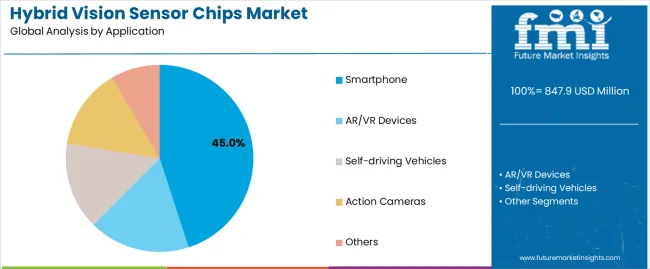
Market Position: Smartphone applications command the leading position in the hybrid vision sensor chips market with 45% market share through proven imaging technologies, including enhanced photo processing, reliable performance capabilities, and mobile optimization that enable device manufacturers to achieve optimal camera performance across diverse photography and video environments.
Value Drivers: The segment benefits from manufacturer preference for high-performance sensor systems that provide consistent image quality, processing reliability, and system flexibility without requiring extensive power consumption. Advanced sensor processing features enable enhanced photography, precise color reproduction, and integration with existing mobile systems, where performance consistency and power efficiency represent critical device requirements.
Competitive Advantages: Smartphone applications differentiate through proven mobile reliability, comprehensive sensor specifications, and integration with established camera systems that enhance imaging effectiveness while maintaining optimal performance standards suitable for diverse photography applications.
Key market characteristics:
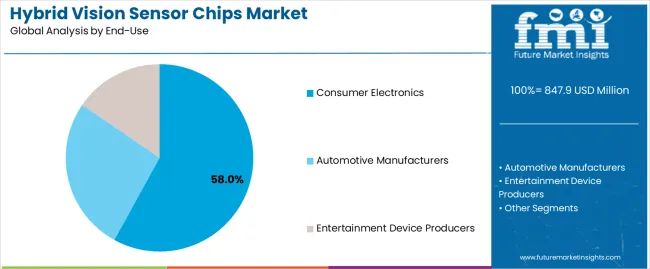
Market Context: Consumer electronics dominate the market with a 58% share, reflecting the primary demand source for hybrid vision sensor chip technology in device optimization and imaging enhancement.
Business Model Advantages: Consumer Electronics provide direct market demand for standardized sensor systems, driving volume production and cost optimization while maintaining performance consistency and reliability requirements.
Operational Benefits: Consumer Electronics applications include device optimization, imaging enhancement, and system reliability assurance that drive consistent demand for sensor systems while providing access to latest processing technologies.
| Category | Factor | Impact | Why It Matters |
|---|---|---|---|
| Driver | Smartphone advancement & mobile photography enhancement (multi-camera systems, computational photography) | ★★★★★ | Growing smartphone market requires advanced image processing systems with enhanced photo capabilities and thermal properties proven effective across mobile applications. |
| Driver | Autonomous vehicle development & computer vision integration (ADAS systems, self-driving platforms) | ★★★★★ | Transforms sensor requirements from "basic image capture" to "precision object recognition"; manufacturers that offer advanced processing systems and AI features gain competitive advantage. |
| Driver | AR/VR market growth & immersive technology development (gaming headsets, virtual platforms) | ★★★★☆ | Modern entertainment facilities need sophisticated, validated sensor systems; demand for certified and compliant vision solutions expanding addressable market. |
| Restraint | High development cost & technical complexity (especially for multi-function applications) | ★★★★☆ | Smaller device manufacturers defer sensor upgrades; increases cost sensitivity and slows advanced technology adoption in price-conscious markets. |
| Restraint | Competition from traditional sensors & technology alternatives (conventional CMOS, specialized chips) | ★★★☆☆ | Alternative sensor technologies limit hybrid adoption and increase competitive pressure, potentially constraining growth in conventional applications. |
| Trend | Advanced AI integration & machine learning capabilities (neural processing, edge computing) | ★★★★★ | Advanced processing properties, performance optimization, and multi-functional capabilities transform operations; AI advancement and machine learning become core value propositions. |
| Trend | Miniaturization & power efficiency optimization (compact designs, low-power operation) | ★★★★☆ | Efficient sensor systems for specific applications and performance protocols; specialized optimization and targeted power management capabilities drive competition toward efficient solutions. |
The hybrid vision sensor chips market demonstrates varied regional dynamics with Growth Leaders including China (15.4% growth rate) and India (14.3% growth rate) driving expansion through consumer electronics development and smartphone manufacturing initiatives. Steady Performers encompass Germany (13.1% growth rate), Brazil (12.0% growth rate), and developed regions, benefiting from established electronics infrastructure and automotive technology sector growth. Mature Markets feature United States (10.8% growth rate), United Kingdom (9.7% growth rate), and Japan (8.6% growth rate), where device modernization and imaging quality requirements support consistent growth patterns.
Regional synthesis reveals Asia Pacific markets leading adoption through electronics manufacturing expansion and smartphone development, while European countries maintain steady expansion supported by automotive integration and technology investment. North American markets show strong growth driven by consumer electronics applications and device modernization trends.
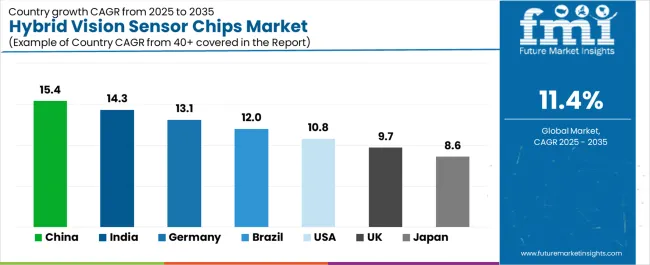
| Country | 2025-2035 Growth | How to win | What to watch out |
|---|---|---|---|
| China | 15.4% | Focus on cost-effective smartphone solutions | Regulatory changes; local competition |
| India | 14.3% | Lead with mobile integration applications | Import restrictions; infrastructure barriers |
| Germany | 13.1% | Provide premium automotive systems | Over-regulation; lengthy approvals |
| Brazil | 12.0% | Offer value-oriented solutions | Currency fluctuations; import duties |
| United States | 10.8% | Push technology integration | Compliance costs; scaling challenges |
| United Kingdom | 9.7% | Focus on consumer applications | Economic impacts; funding constraints |
| Japan | 8.6% | Emphasize precision manufacturing | Traditional preferences; adoption rates |

China establishes fastest market growth through aggressive smartphone manufacturing programs and comprehensive consumer electronics facility expansion, integrating advanced hybrid vision sensor chips as standard components in mobile devices and automotive systems. The country's 15.4% growth rate reflects government initiatives promoting electronics modernization and domestic sensor capabilities that mandate use of precision imaging systems in consumer and automotive facilities. Growth concentrates in major technology regions, including Shenzhen, Beijing, and Shanghai, where electronics development showcases integrated sensor systems that appeal to device manufacturers seeking imaging capabilities and mobile applications.
Chinese manufacturers are developing cost-effective sensor solutions that combine domestic production advantages with advanced image processing features, including enhanced photo quality and improved performance capabilities. Distribution channels through electronics suppliers and device integrators expand market access, while government support for technology development supports adoption across diverse smartphone and automotive segments.
Strategic Market Indicators:
In Mumbai, Bangalore, and Delhi, electronics facilities and smartphone operators are implementing hybrid vision sensor chips as standard equipment for imaging optimization and device performance applications, driven by increasing government technology investment and electronics development programs that emphasize importance of precision imaging capabilities. The market holds a 14.3% growth rate, supported by government electronics initiatives and facility modernization programs that promote advanced sensor systems for consumer and automotive facilities. Indian operators are adopting imaging systems that provide consistent photo quality and performance features, particularly appealing in regions where device optimization and operational excellence represent critical technology requirements.
Market expansion benefits from growing electronics capabilities and international technology partnerships that enable domestic production of advanced sensor systems for consumer and automotive applications. Technology adoption follows patterns established in smartphone equipment, where performance and efficiency drive procurement decisions and operational deployment.
Market Intelligence Brief:
Germany's advanced automotive market demonstrates sophisticated hybrid vision sensor chip deployment with documented performance effectiveness in vehicle applications and consumer facilities through integration with existing automotive systems and device infrastructure. The country leverages engineering expertise in imaging technologies and precision systems integration to maintain a 13.1% growth rate. Technology centers, including Bavaria, Baden-Württemberg, and North Rhine-Westphalia, showcase premium installations where sensor systems integrate with comprehensive automotive platforms and facility management systems to optimize imaging quality and operational effectiveness.
German manufacturers prioritize system quality and EU compliance in sensor development, creating demand for premium systems with advanced features, including facility integration and quality management systems. The market benefits from established automotive infrastructure and willingness to invest in advanced imaging technologies that provide long-term operational benefits and compliance with international automotive standards.
Market Intelligence Brief:
Brazil's market expansion benefits from diverse electronics demand, including smartphone modernization in São Paulo and Rio de Janeiro, consumer facility upgrades, and government technology programs that increasingly incorporate precision sensor solutions for electronics applications. The country maintains a 12.0% growth rate, driven by rising electronics activity and increasing recognition of imaging benefits, including accurate photo control and enhanced device effectiveness.
Market dynamics focus on cost-effective sensor solutions that balance imaging performance with affordability considerations important to Brazilian electronics operators. Growing technology development creates continued demand for modern sensor systems in new electronics infrastructure and facility modernization projects.
Strategic Market Considerations:
United States establishes market leadership through comprehensive consumer electronics programs and advanced automotive technology infrastructure development, integrating hybrid vision sensor chips across smartphone and automotive applications. The country's 10.8% growth rate reflects established technology relationships and mature imaging technology adoption that supports widespread use of precision sensor systems in consumer and automotive facilities. Growth concentrates in major technology centers, including California, Texas, and the Northeast, where sensor technology showcases mature deployment that appeals to device manufacturers seeking proven performance capabilities and imaging optimization applications.
American technology providers leverage established distribution networks and comprehensive technical support capabilities, including system design programs and training support that create customer relationships and operational advantages. The market benefits from mature regulatory standards and technology requirements that mandate sensor system use while supporting technology advancement and performance optimization.
Market Intelligence Brief:
United Kingdom's technology market demonstrates integrated hybrid vision sensor chip deployment with documented performance effectiveness in consumer applications and automotive facilities through integration with existing technology systems and device infrastructure. The country maintains a 9.7% growth rate, supported by operational efficiency programs and imaging quality requirements that promote precision sensor systems for consumer applications. Technology facilities across England, Scotland, and Wales showcase systematic installations where sensor systems integrate with comprehensive consumer platforms to optimize precision and operational outcomes.
UK technology providers prioritize system reliability and device compatibility in sensor procurement, creating demand for validated systems with proven performance features, including quality monitoring integration and data management systems. The market benefits from established consumer infrastructure and quality requirements that support imaging technology adoption and operational effectiveness.
Market Intelligence Brief:
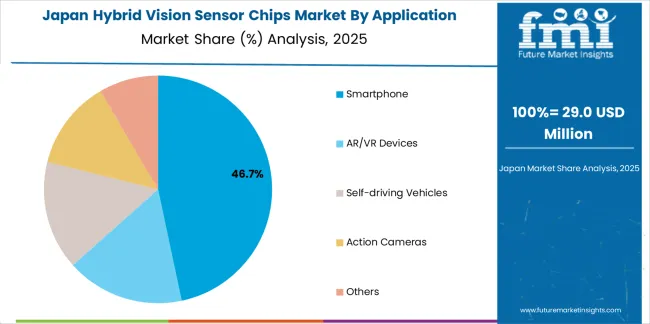
Japan's market growth benefits from precision electronics demand, including advanced consumer facilities in Tokyo and Osaka, quality integration, and precision enhancement programs that increasingly incorporate sensor solutions for electronics applications. The country maintains an 8.6% growth rate, driven by imaging technology advancement and increasing recognition of precision sensor benefits, including accurate image modification and enhanced operational outcomes.
Market dynamics focus on high-precision sensor solutions that meet Japanese quality standards and electronics effectiveness requirements important to device operators. Advanced electronics technology adoption creates continued demand for sophisticated sensor systems in consumer facility infrastructure and operational modernization projects.
Strategic Market Considerations:
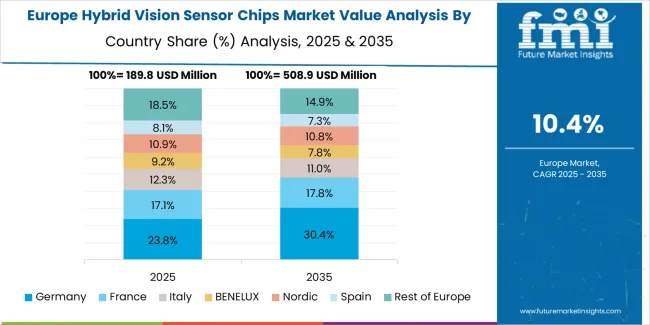
The European hybrid vision sensor chips market is projected to grow from USD 215.4 million in 2025 to USD 621.3 million by 2035, registering a CAGR of 11.2% over the forecast period. Germany is expected to maintain its leadership position with a 28.7% market share in 2025, supported by its advanced automotive infrastructure and major electronics manufacturing centers.
United Kingdom follows with a 21.3% share in 2025, driven by comprehensive consumer technology programs and device development initiatives. France holds an 18.9% share through specialized electronics applications and device compliance requirements. Italy commands a 14.2% share, while Spain accounts for 9.6% in 2025. The rest of Europe region is anticipated to gain momentum, expanding its collective share from 7.3% to 8.1% by 2035, attributed to increasing sensor adoption in Nordic countries and emerging electronics facilities implementing technology modernization programs.
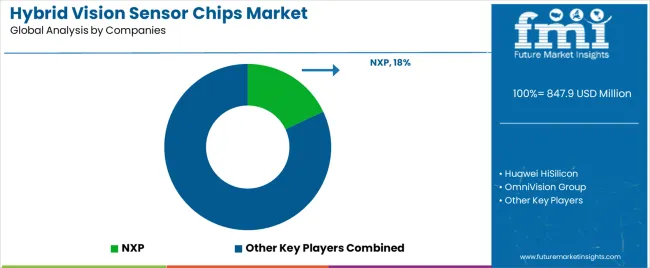
| Stakeholder | What they actually control | Typical strengths | Typical blind spots |
|---|---|---|---|
| Global brands | Distribution reach, broad product catalogs, brand recognition | Wide availability, proven performance, multi-region support | Product refresh cycles; customer dependency on brand validation |
| Technology innovators | Sensor R&D; advanced processing architectures; enhanced performance properties | Latest technologies first; attractive ROI on performance effectiveness | Service density outside core regions; scaling complexity |
| Regional specialists | Local compliance, fast delivery, nearby customer support | "Close to customer" support; pragmatic pricing; local regulations | Technology gaps; talent retention in customer service |
| Full-service providers | Complete sensor programs, system integration, performance monitoring | Lowest operational risk; comprehensive support | Service costs if overpromised; technology obsolescence |
| Niche specialists | Specialized applications, custom configurations, technical services | Win premium applications; flexible configurations | Scalability limitations; narrow market focus |
| Item | Value |
|---|---|
| Quantitative Units | USD 847.9 million |
| Chip Type | Single Function Chip, Multi-function Chip |
| Application | Smartphone, AR/VR Devices, Self-driving Vehicles, Action Cameras, Others |
| End Use | Consumer Electronics, Automotive Manufacturers, Entertainment Device Producers |
| Regions Covered | North America, Latin America, Western Europe, Eastern Europe, Asia Pacific, South Asia, Middle East & Africa |
| Countries Covered | China, India, Germany, Brazil, United States, United Kingdom, Japan, Canada, France, Australia, and 25+ additional countries |
| Key Companies Profiled | NXP, Huawei HiSilicon, OmniVision Group, AlpsenTek, Anhui Eyevolution Technology, Samsung Electronics, Sony Corporation |
| Additional Attributes | Dollar sales by chip type and application categories, regional adoption trends across Asia Pacific, North America, and Europe, competitive landscape with sensor manufacturers and system integrators, device operator preferences for sensor effectiveness and performance control, integration with consumer platforms and monitoring systems, innovations in imaging technology and performance enhancement, and development of advanced sensor solutions with enhanced reliability and operational optimization capabilities. |
The global hybrid vision sensor chips market is estimated to be valued at USD 847.9 million in 2025.
The market size for the hybrid vision sensor chips market is projected to reach USD 2,495.7 million by 2035.
The hybrid vision sensor chips market is expected to grow at a 11.4% CAGR between 2025 and 2035.
The key product types in hybrid vision sensor chips market are smartphone, ar/vr devices, self-driving vehicles, action cameras and others.
In terms of end-use, consumer electronics segment to command 58.0% share in the hybrid vision sensor chips market in 2025.






Full Research Suite comprises of:
Market outlook & trends analysis
Interviews & case studies
Strategic recommendations
Vendor profiles & capabilities analysis
5-year forecasts
8 regions and 60+ country-level data splits
Market segment data splits
12 months of continuous data updates
DELIVERED AS:
PDF EXCEL ONLINE
Hybrid Printing Market Forecast Outlook 2025 to 2035
Hybrid Boat Market Size and Share Forecast Outlook 2025 to 2035
Hybrid Metal-Paper Seamers Market Size and Share Forecast Outlook 2025 to 2035
Hybrid Sealing-Cut Machines Market Analysis - Size and Share Forecast Outlook 2025 to 2035
Hybrid Powertrain Market Size and Share Forecast Outlook 2025 to 2035
Hybrid Additive Manufacturing Machines Market Size and Share Forecast Outlook 2025 to 2035
Hybrid Integration Platform Market Size and Share Forecast Outlook 2025 to 2035
Hybrid Marine Gensets Market Size and Share Forecast Outlook 2025 to 2035
Hybrid Meat Products Market Size and Share Forecast Outlook 2025 to 2035
Hybrid Generator Sets Market Size and Share Forecast Outlook 2025 to 2035
Hybrid Switchgear Market Size and Share Forecast Outlook 2025 to 2035
Hybrid Rice Seeds Market Size and Share Forecast Outlook 2025 to 2035
Hybrid Memory Cube Market Size and Share Forecast Outlook 2025 to 2035
Hybrid Aircraft Market Size and Share Forecast Outlook 2025 to 2035
Hybrid Solar Wind Market Size and Share Forecast Outlook 2025 to 2035
Hybrid Cutters Market Analysis Size and Share Forecast Outlook 2025 to 2035
Hybrid Fabrics Market Size and Share Forecast Outlook 2025 to 2035
Hybrid Train Market Analysis - Size, Share, and Forecast Outlook 2025 to 2035
Hybrid Solar Wind Energy Storage Market Size and Share Forecast Outlook 2025 to 2035
Hybrid Drivetrain Market Size and Share Forecast Outlook 2025 to 2035

Thank you!
You will receive an email from our Business Development Manager. Please be sure to check your SPAM/JUNK folder too.
Chat With
MaRIA